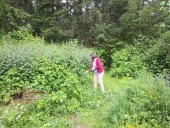If you want to do a little fancy, nettle ravioli is really lovely. The filling is dense and very earthy.
Pasta dough
2 cups flour (or try 3 oz flour per egg)
3 eggs
pinch salt
Filling
50 g stinging nettle leaves
1 clove garlic
25g by weight of pine nuts (try other nuts!)
1 egg
salt and pepper
a little oil
Sauce
1/4 cup butter per 16 ravioli
1 clove garlic, pressed
1 Tbsp snipped fresh basil, sage, oregano, Italian (flat-leaf) parsley, and/or chives or 1/2 teaspoon fresh thyme leaves
Garnish
Ground black pepper
Grated parmesan
Pasta - part 1
On a board or the counter, make a mound of flour, sprinkle on the salt, create a bowl in the centre of the flour mound, crack in the eggs and start combining with your fingers. You should end up with a very dry dough, almost cracking. Cover and allow to rest for 1 hour.
Filling
Simmer all the nettles in a little water for ten minutes then drain.
Put the nettle on a strong paper towel or tea towel, fold the towel to encase the nettle, and twist to squeeze out the excess water. The nettle should be a little clump of pressed material when you're done. Chop finely.
Roughly grind the pine nuts.
In a small bowl whisk the egg. Mix in the chopped nettles, pressed garlic, pine nuts, salt and pepper.
Heat a small non-stick pan, add a little oil, and dump in the egg and nettle mixture. Cook just until the egg starts to solidify.
Set aside while rolling out the pasta.
Pasta - part 2
After the hour of rest, knead the dough for about 10 minutes before running it through the pasta machine.
Divide the dough into two balls and roll as thin as you can (1/8" or thinner) or run through the pasta machine up to the thinnest setting. If the dough is sticky when you're rolling it, there isn't enough flour, so sprinkle some on, fold, and run it through again until it becomes a nice smooth sheet.
To stuff the ravioli, lay out one sheet. Evenly space out small lumps of the filling allowing plenty of room of virgin dough to make a good seal. Brush around the filling with water.
Lay the second sheet on top, smoothing out and pressing gently to make the two sheets touch around the stuffing and seal with the help of the dampened bottom sheet (this last bit can also be done after cutting the shapes).
Cut out the ravioli in circles or squares with a knife or pasta cutter. Press out any remaining air bubbles and be OCD about pressing the edges a lot.
While bringing a large pot of salted water to a simmer, prepare the sauce.
The Sauce
In a medium saucepan, heat the butter to a froth and cook about 4-5 minutes.
Add the pressed garlic and mix to break up the garlic. Continue cooking and stirring over medium heat until the butter is lightly browned, another 2-4 minutes.
Remove from heat and stir in the herb(s).
The Big Finish
Reduce the heat under the boiling water and let it slow to a gentle simmer. Carefully drop in the ravioli and cook until they rise to the surface and puff up (3-4 minutes).
With a slotted spoon remove the ravioli and put directly in the sauce, covering them with the butter sauce before dropping in the next one.
Plate the ravioli, drizzle any remaining sauce on top, and garnish with fresh ground pepper and parmesan.





